Introduction
On June 2, 2019, I began serving as Pastor of the Second Missionary Baptist Church (SMBC) in Jacksonville, Florida. The Church, SMBC, is in a neighborhood known as Lavilla. Historically, Lavilla was a thriving neighborhood in downtown Jacksonville, specifically for African Americans. The neighborhood became a hub for black culture in Jacksonville during the segregation era. Author and activist James Weldon Johnson, the author of “Lift Every Voice and Sing, ” was often referred to as the “black national anthem” born in Lavilla. Seventy percent of Lavilla’s population consisted of African Americans, many of whom worked in the booming hotel, lumber, port, buildings, and railroad industries in Jacksonville, Florida. Lavilla provided African Americans with excellent educational and occupational opportunities. (metrojax) However, due to desegregation, gentrification, and lack of resources, the landscape of Lavilla changed significantly. The once-thriving neighborhood is now an area plagued with homelessness, poverty, high unemployment rates, underserved schools, illegal drugs, and high crime rates. When driving around Lavilla, one cannot help but notice the suffering and devastation present within the community. The Lavilla neighborhood is a community in need of restoration and revitalization.
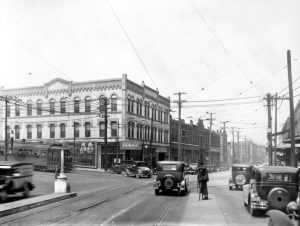
Historic Lavilla, Looking west towards Railroad Row at the intersection of West Bay and Broad streets. Railroad Row was a mixed use district filled with hotels, restaurants, bars and wholesale industrial uses between Downtown Jacksonville and the Jacksonville Terminal. Courtesy of the State Archives of Florida. (1)
Like, the community, Second Baptist was a thriving and vibrant church with over 60 – 75 family and community-based ministries. SMBC membership was of over 2,500 active members at its peak, building a brand-new church facility in 1979. The Jacksonville city council officially designated the old sanctuary next to the new church as a historic landmark on December 9, 2014. However, SMBC experienced significant change and decline within the last thirty years.
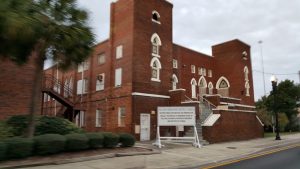
The Late Gothic Revival-style Second Missionary Baptist Church at 954 Kings Road was built by James Edward Hutchins in 1930. (2)
The once multigenerational church dwindled to the following membership: 3 percent of membership between the ages of 16-19, 5 percent between the ages of 20-29, 1 percent between the ages of 30-39, 4 percent between the ages of 40-49, 11 percent between the ages of 50-59, 25 percent between the ages of 60-69, and 51 percent between the ages of 70-79.
In calculating membership by years: 2 percent of the congregation have been members between 1-2 years, 3 percent have been members between 3-5 years, 4 percent have been members between 6-9 years, 14 percent have been members between 10-19 years and 77 percent have been members 20 plus years. During my short tenure the membership increased 25 percent membership for sixteen through forty-five.
One of the significant reasons Second Baptist experienced such a sharp decline was due to the changes in the community. State laws passed near the turn of the century effectively disenfranchised most of the surrounding black neighborhoods. When segregation ended, many of the area residents, some former members of SMBC, moved out of the community looking for jobs and opportunities. Gentrification hidden behind the revitalization language led to the eradication of many neighborhoods, businesses, and schools. By the mid-eighties and early nineties, the Lavilla community became a shell of its former self, composed primarily of abandoned buildings and drug dens. As the population of Lavilla changed, so did Second Missionary Baptist church. The decline of the community and the decline of SMBC were connected. If SMBC and the community declined together, they must thrive together. If Second Baptist experiences revitalization and restoration, which is the church’s goal, will only happen in relationship with the community. As the community grows, so will the SMBC. The church, as I see, is a reflection of the community.
Getting acquainted with the SMBC, I noticed the lack of attention given to the people and the community’s issues. I wondered why the congregation did not have any ministries that dealt with any of the above problems.
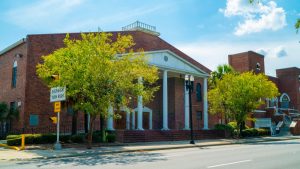
Current sanctuary where members actively participate in worship.
Photo taken by author, Derrick Mercer. (3)
Close to halfway into my pastoral tenure, I called together the church leaders for a roundtable meeting. The church leaders consist of deacons and trustees. The Baptist church is democratic, and the congregation can choose their leaders through 2/3 majority of the vote. The deacons have the task of taking care of the immediate needs of the congregation, and the trustees oversee the financial operation of the church. Any ministry idea must pass through the deacons and the trustees for approval before being presented to the congregation for final approval. The congregation looks to the leadership for guidance and direction. As a result of the influence deacons and trustees carry within the congregation, it is crucial for a Pastor, particularly a new Pastor in a Baptist church, to build a relationship with this leadership body.
The meeting was very informal. In the meeting, I asked a series of questions:
- What does this church mean to you?
- What are you most proud of about our church?
- What concerns or bothers you the most?
- What do you think we can do better and how?
- How do you define the mission of the church?
- How do you define a good pastor?
- How do you define a good member?
- Do you think this church can grow? If yes, how?
- Is there anything else you want to share with me as your new pastor?
I requested the group to anonymously respond to these questions on a piece of paper and submit them to me for further discussion. The question: “How do you define the church’s mission?” garnered a series of responses with similar themes. Most of the feedback to this question focused on piety. Saving souls, leading persons into a relationship with Jesus Christ, knowing and teaching the word of God is viewed as the primary mission of the church. Not once was Justice mentioned. However, helping persons in the community is mentioned, but very vaguely. I knew that Second Baptist was only going to be as strong as the community. If we want to see SMBC thrive, we must understand the church will only succeed to the degree the community thrives. Our community needs major revitalization and restoration. But this is good news because restoration is at the heart of the gospel, Jesus Christ came to bring restoration. Restoration comes through justice.
What is Justice?
I define justice as the guarantee of human equality. Equality builds fairness and impartiality and is the state of being equal in rights, status, and opportunities. Equality is about freedom. Freedom is at the heart of the mission of Jesus Christ. (Luke 4:18) Freedom is the ability to carve out individual destiny without any hindrance. Not only is justice about equality, but justice is also the guarantee of human equity. I understand equity as guaranteed access to all of the necessities of life. Equity ensures that everyone, regardless of race, gender, religion, and sexuality, has all of the resources needed for full and healthy lives, which is the purpose of the gospel. However, we often limit the gospel to a personal experience disconnected from our call to the surrounding world.
Project Focus
After our small group meeting, I started asking how a pastor can help a congregation focus on individual salvation (piety) to expand their conception of God’s calling to include a ministry of Justice? How does a pastor help a congregation see Justice as central to the mission of a church? My thoughts to achieve this by utilizing a sermon series to awaken the congregation to God’s call to justice. Sermon Series are popular tools used by pastors to highlight specific themes in scriptures. We use sermon series teach on themes such as love, faith, stewardship, etc. However, I have discovered that rarely do we dedicate an entire series to the subject of Justice. How can this be when Justice is such a consistent theme through the scriptures. We cannot expect our congregations to be committed to Justice if we do not emphasize justice in our preaching calendar. I argue that in the times we live, racial hostility, widening wealth gap, mass incarceration, inequality, black bodies killed by police, etc. Justice must be primary.
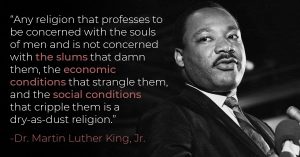
Pictured: Martin Luther King, Jr. and his quote that reads “Any religion that professes to be concerned with the souls of men and is not concerned with the slums that damn them, the economic conditions that strangle them, and the social conditions that cripple them is a dry-as-dust religion.” (4)
Sermon Series Outline
I divided the sermon series into three parts and each part aligning with the heading:
- The Bible and justice
- Jesus and Justice
- The Church and Justice
The Bible and Justice focused on justice as an overarching theme in the entire bible. I highlighted God’s concern for justice in the Old and New testament.
The Bible and Justice
Sermon 1
Title: The God of the Oppressed!
Text: Exodus 2:23-3:15
The story of the Exodus reveals the heart of God for justice. This story reveals a God who does not sit idly by while his people suffer, but a God concerned about their welfare and a God who willingly gets INVOLVED to alleviate the suffering of the people of God.
Sermon 2
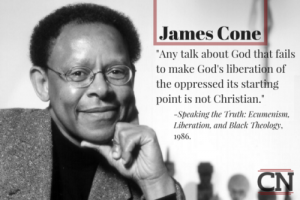
James Cone quote “Any talk about God that fails to make God’s liberation of the oppressed its starting point is not Christian.” (5)
Title: Non-negotiable.
Text: Micah 6:8
This passage reveals a God who makes justice a requirement for his people. Doing Justice is seen as an act of obedience. Obedience is how we prove our love for God. (John 14:15)
Sermon 3
Title: Misguided Worship
Text: Isaiah 58:1-12
Isaiah 58 attempts to address the issue of personal piety while ignoring the call to justice within society. In this passage, churches emphasize specific religious observances, rituals, and traditions instead of justice. Justice is essential.
Jesus and Justice.
I incorporated the second part: Jesus and Justice to highlight God’s call to justice within the new testament. Jesus and Justice aimed to narrow our focus on justice in relationship with the person and purpose of Jesus Christ.
Sermon 1
Title: The Mission of Jesus
Text: Luke 4:18-19
This text shows this primary mission as to why Jesus Christ came into the earth. When asked: what is the mission of Jesus Christ? Many Christians respond by saying Christ came to offer salvation by dying for our sins on the cross and through the resurrection. In no way do I disagree with this response. However, when we speak about the mission of Christ in the world, it is essential to allow the scriptures to speak. Jesus Christ explicitly states in mission in Luke 4. In Luke 4, Jesus places freedom at the heart of his mission.
Sermon 2
Title: Go and Do Likewise
Text: Luke 10:25-37
One of the most famous parables told by Jesus is probably the parable of the Good Samaritan. I love this parable because this parable contains many attributes as it relates to the work of Justice.
Sermon 3
Title:The Pursuit of Happiness
Text: Matthew 5:1-12:
This sermon focuses on Jesus’ famous sermon on the mount. This sermon aimed to redefine happiness according to the values of the kingdom of God. Values are essential because our values dictate how we think and, ultimately, how we live, which is what Jesus teaches in the sermon on the mount. Christ teaches us a different value system, a way of life that is radically different from the course of the world around us.
The Church and Justice.
The final part of this series was to show through scripture examples of the church involvement in justice and caring for the community. This part was also aimed to suggest ways to live out our call to do justice through the evangelism.
Sermon 1:
Title: Get in the Streets
Text: Acts 3:1-10
This sermon is a call for the church to think outside of the four walls of the church. Ministry takes place within but also outside of the church building. Sometimes we can be so focused on the church, such as church programming, that we overlook what’s most important. Such as it is in the case of Acts 3:
Sermon 2:
Title: A Blueprint to Follow
Text: Acts 2:41-47
The early church in Acts gives us a fantastic blueprint for us to follow as the body of Christ. Right from the beginning, we see the work of Justice at the forefront of the church.
Sermon 3:
Title: The Mission of the Church
Text: Matthew 28:18-20
These verses are commonly known as the great commission. Instruction, command, or duty given to a person or group defines commission. This message aimed to show the relationship between the great commission and the call to justice.
Interpretation
My research uncovered the lack of attention churches, particularly pastors’ give to the theme of justice when constructing their preaching calendar. During my research process, I created a congregational survey sent through email.
The survey included the following questions:
- How would you describe the relationship between our church (SMBC) and the surrounding community?
- How do you define Justice?
- How often do you hear sermons talking about justice?
- Do you notice any opportunities for justice in the Lavilla Community? If so, please explain.
As I read through the responses, I was shocked to discover that many of the parishioners have never walked through an entire sermon series on the topic of Justice. Of course, many of the congregants heard messages on the importance of caring for others and helping those who are less fortunate, but this does not quite meet the call of justice.
I also discovered that justice is often confused with charity. Many of the examples given to define justice were charity examples. When asked about opportunities for justice in the community? Responses varied from starting a food pantry, providing clothes, visiting and providing services for the surrounding homeless shelters and nursing homes, etc. All of these are great examples of ways we can help the community. Charity is important. One of the initiatives that came out of this project was the development of a food pantry. (see video). To help solve food insecurity in our neighborhood, especially during covid-19, SMBC established a drive-by food pick-up for the community. At the same time, I love this program, and it is a step in the right direction. I wanted to make sure the parishioners understood that justice goes beyond acts of charity. Charity helps persons survive “within” the system. Justice aims at changing the system, which makes charity necessary, which was the purpose of the Acts 3 sermon. In Acts 3, we meet a man who lived off of handouts. The reason why the man needed a handed was that he was born crippled. The man did not need help because he was lazy. He required a handout because he was born in a condition that made needing help necessary. Peter and John performed justice because instead of giving him a charity donation, they, through Jesus Christ, fixed his situation. As a result of a changed condition, he no longer needed a handout.
The example of the crippled man is a picture of justice. Justice aims to change conditions that contribute to suffering. Justice deals with the root causes of social problems and directs towards systems and structures that perpetuate injustice and inequality. Many persons desire to do justice, but they do not know how or where to start due to the little attention given to justice. If we want to see a commitment to justice in our congregations, Pastors must make justice a part of their yearly preaching calendar. I believe that nothing shapes and forms a congregation like the preaching of the word of God. The word of God is what equips the congregation for good works (2 Timothy 3:16-17). We must be intentional and deliberate in reminding our congregation by preaching the importance of being committed to justice. Below is a list of resources for Pastors’ who desire to preach justice.
We must be deliberate in preaching justice and intentional in equipping our congregation and providing opportunities for them to practice justice. Developing practices for justice was a challenge during my research. I have discovered that person’s desire to do justice but do not know how to start beyond voting. One of the resources that helped me think through how my congregation can practice justice was a book written by Kent Annan entitled: “Slow Kingdom Coming: Practices for doing justice, loving mercy, and walking humbly in the world.” Kent Annan suggests five practices:
- Attention: awakening to Justice
- Confession: the posture of Engaging
- Respect: the golden rule for helping
- Partnering: with not for
- Truthing: hard thinking and feet on the Ground
Wednesday’s Bible Study allowed us to go through this book as a congregation and discuss ways to get involved in justice.
As a result of this study, we could partner with an organization rooted in doing justice with the community called “ICARE”. ICare was formed in 1997 by a diverse coalition of congregations. ICare aims to use ministry networks to hold elected officials accountable and powerfully address community problems. ICare is known for establishing the Nehemiah assembly in Jacksonville, Florida. In Nehemiah 5:1-13, we learn how Nehemiah used the power of the people to do justice successfully. From this partnership, the creation of “Engage” was implemented. “Engage” aims to create space for persons in the community to come to church and share stories about events in their community. I love that ICARE is the unity among congregations, transcending our religious and denominational affiliations to achieve one goal: justice. ICARE allowed us to get in front of elected officials to share concerns and develop strategies to solve problems plaguing the community. (picture of Nehemiah assembly) Churches who are trying to be faithful to the call of God to justice, can benefit from partnering and working aside organizations such as “ICARE” as a starting point.
My plan moving forward is to continue to structure SMBC around God’s call to justice. I want justice to be a part of the DNA of the church. We are currently developing our new members’ orientation packet. We will implement the section on Jesus and Justice as part of the course. To keep the congregation engaged, I plan to do a series on Justice every year throughout my tenure. Right now, SMBC currently has ten active ministries; these ministries were in place before my arrival. These ministries include Deacons/Deaconess, Trustees, Men, Women, Married, Senior/Retiree, and children. As we continue to build and structure SMBC, I want to make sure each ministry is involved in the work of justice. One way I plan to ensure ministry involvement is to challenge each ministry to plan and participate in a justice project every year. As a Pastor, I aim to continue researching and studying practices for congregations seeking to do justice. While we still have a way to go, I am thankful for a congregation allowing a young man to come in and seek to cast a vision of restoration for the glory of God and the good of the community.
Book suggestions for preaching Justice:
- Preaching God’s Transforming Gospel: A lectionary commentary by Ronald Allen, Dale P Andrews and Dawn Ottoni-Wilhem
- Exodus Preaching: Crafting sermons about justice and hope by Kenyatta Gilbert
- The Day the Revolution Begin: Reconstructing the meaning of Jesus Crucifixion by N.T Wright
- How to Preach a Dangerous Sermon by Frank Thomas
Book suggestions for practicing Justice:
- Slow Kingdom Coming: Practices for doing Justice, Loving Mercy, and Walking Humbly in the World by Annan Kent
- The Dangerous Act of Worship: Living God’s Call to Justice
- Woke Church: An Urgent Call for Christians in America to Confront Racism and Injustice by Eric Mason
- Having Nothing, Possessing Everything: Finding Abundant in Communities in Unexpected Places by Micheal Mather
Works Cited:
(1) Ennis, D. (2019). Vintage Photos: Vibrant Lavilla. The Jaxson.
https://www.thejaxsonmag.com/article/vintage-photos-vibrant-lavilla/
(2) Ennis, D. (2021). The Black Church: Jacksonville. The Jaxson.
https://www.thejaxsonmag.com/article/the-black-church-jacksonville/
(3) Mercer, D. (2020) Second Missionary Baptist Church. Personal Photo
(4) Niedzjela. C. (2020). What does it really mean to love your neighbor? The Politics Society
https://www.politicsatnyu.org/zeitgeist/2020/11/what-does-it-really-mean-to-love-your-neighbor/
(5) Pease, C. (2018). The cross and the lynching tree. The Moral Universe
https://moraluniversecynthia.wordpress.com/tag/james-h-cone/
(6) Youtube: Second Missionary Baptist Church Food Drive
https://www.youtube.com/watch?v=UqXRYnWGTd4
(7) ICare: Interfaith Coalition for Action, Reconciliation & Empowerment
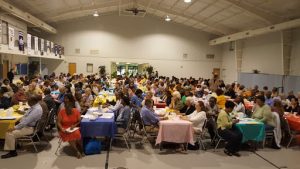
Derrick,
Thank you for this very clear and informative overview. It complements in written paper in very helpful ways, such as the more extensive review of Lavilla’s historical significance and development, the ways you assessed the impact of the sermon series, and the account of the church’s partnership with ICARE. The presentation is put together in a compelling and illuminating way. Well done.